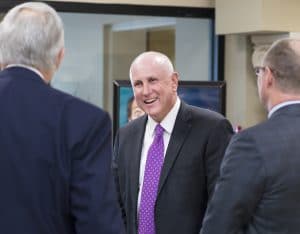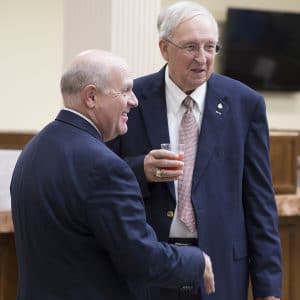
Col. (Ret.) Mark Tillman speaks to well-wishers at Farmers Bank & Trust in Magnolia, Arkansas on Thursday, Oct. 5, 2017, prior to delivering the program at the 13th Annual Farmers Bank and Trust Distinguished Speaker Series banquet at SAU.
A large crowd heard stories of heroism and patriotism on Thursday, Oct. 5, as Col. (Ret.) Mark Tillman, the nation’s 12th presidential pilot, delivered the program at the 13th Annual Farmers Bank and Trust Distinguished Speaker Series banquet at the Donald W. Reynolds Campus and Community Center at Southern Arkansas University.
Tillman was at the controls of Air Force One on Sept. 11, 2001, protecting President George W. Bush by keeping him out of harm’s way and connecting the airborne Oval Office to the nation’s first responders. He served as pilot and commander of Air Force One from 2001-2009. His distinguished career spans 30 years in the U.S. Air Force. Tillman was awarded the Distinguished Flying Cross in 2004 and promoted to Brigadier General by the President, the first military line officer to receive this honor.
He regaled his audience with the story of Sept. 11, as he experienced it from the cockpit of Air Force One.
“It’s 8:40 a.m. and I’m moving through the plane, inspecting each room,” Tillman said of that morning. “At 8:47, the time of the first attack, the PA system comes on and I’m told to pick up the white phone. The radio operator says, ‘You gotta see what’s going on.’ The first tower had been hit.”
At that moment, no one knew the nation had come under attack by hijackers. “There was no real concern about the first plane,” Tillman said. “There was not a terrorist threat.”
President Bush was at an elementary school in Sarasota, Fla., at the time of the second attack. “I was doing final inspection when I’m told to pick up the beige phone. That’s when I heard about the second tower and realized the nation was under attack. I told the staff that we were at war and that this was not an exercise.”
Then-White House Chief of Staff Andrew Card informed Bush of the attacks, “and we began making plans to relocate the President,” Tillman said. “The President was firm – he would not be relocated, he would be repositioned to Washington, D.C. Those were his orders.”
As Bush started moving from the elementary school to the airplane, “we learned that the Pentagon had been hit by an airliner,” Tillman said. “Reports were there were truck bombs and car bombs exploding in the Capital area – it made no sense to bring the President to D.C. because of the air and ground threat.”
In the sky over Florida, Air Force One received a report of another plane “above us and descending. We had reports there were nine aircraft hijacked. Three had hit their targets and there was a fourth over the Ohio Valley, maybe turning back toward New York. We had one aircraft over us – we saw it on our electronics. Our plan was to change direction and see if it followed us.”
The second plane did not follow Air Force One, but was revealed to be a plane that had lost its transponder.
Tensions increased as Tillman got word that the fourth aircraft was indeed headed toward Washington and that D.C. “wasn’t a safe place for the President.” He redirected the jet for Barksdale Air Force Base in Louisiana. Over the Gulf of Mexico, he said, another potential threat arose.
“We were told there were jets behind us, and that foreign nationals training in that area were to take out ‘Angel’ next. That was code for Air Force One. These were two fast-movers coming up over the Gulf and no one knew who they were.”
It was determined, however, that the fighters were from a unit in Texas and were to provide cover for the presidential plane as it crossed the Gulf.
Bush landed at Barksdale, the most secure base in the world, Tillman said, and addressed the nation from there. However, Tillman was informed by military officials on the site that a nuclear exercise was being conducted. “The B-52s were hot,” Tillman said to laughter, “and I was told that maybe it wasn’t the best place to bring the President.”

Dr. Trey Berry, left, president of Southern Arkansas University, and Dr. Bob Burns, chairman of the board, Farmers Bank & Trust, visit during the reception held for Col. (Ret.) Mark Tillman at Farmers Bank in Magnolia on Thursday, Oct. 5, 2017.
He spoke admiringly of the support of fighter aircraft joining the wing of Air Force One as he flew Bush across the country that day. “There were six planes flying over the Shenandoah Valley,” he said of the presidential jet and its escorts. “We had F-16s from Andrews Air Force Base flying off the fuselage. One of the pilots was giving our crew a thumb’s up from the cockpit. It was a real morale-builder.”
Tillman also spoke about his successful mission to fly Bush – secretively – into Iraq to have dinner with the troops in 2003. “He told me, ‘Tillman, all you have to do is fly me out of the United States, to dinner in Baghdad, and back home.’ I appreciated that – he always kept it simple. I said, ‘Sir, I’m honored.’”
The mission was carried out in complete secrecy and involved transporting Bush and his team from Crawford, Texas, to Washington, D.C., swapping planes in the process. “I’m in the cockpit flying, and Bush says, ‘Tillman, what’s it like flying the President of the United States into a war zone? I said, ‘Yeah, Mr. President, it’s great,’” Tillman said, to laughter.
Later in the evening, Tillman related “the coolest” story about traveling with President Bill Clinton in the 1990s. “We flew Clinton to Jackson Hole, Wyoming, and put the plane away in a hangar up there,” Tillman said. “We’re sitting there in the hangar and I’m told there’s a guy out front who wants to see me. So there’s a guy on a motorcycle and he takes off his helmet and it’s Harrison Ford. He says he’s going to make a movie called ‘Air Force One,’ and would like a tour of the plane. He gives us the script.”
“Ford starts to walk into the hangar, and we start to let him know he can’t just go in there, and he says, ‘It’s my hangar.’ Later, when the movie comes out, President Clinton wants to know if there’s really an escape pod on board, because he saw it in the movie. I go, ‘No, Mr. President, I’m sorry, that was just in the movie.’ Then he comes back and asks about parachutes. I go, ‘No, sir, we don’t have any parachutes.’ He comes back again and says, ‘Not even one?’”
The endowment created through this event provides scholarships that allow deserving students to experience outstanding educational opportunities at SAU. A reception was held prior to the lecture at the Main Branch of Farmers Bank and Trust.
